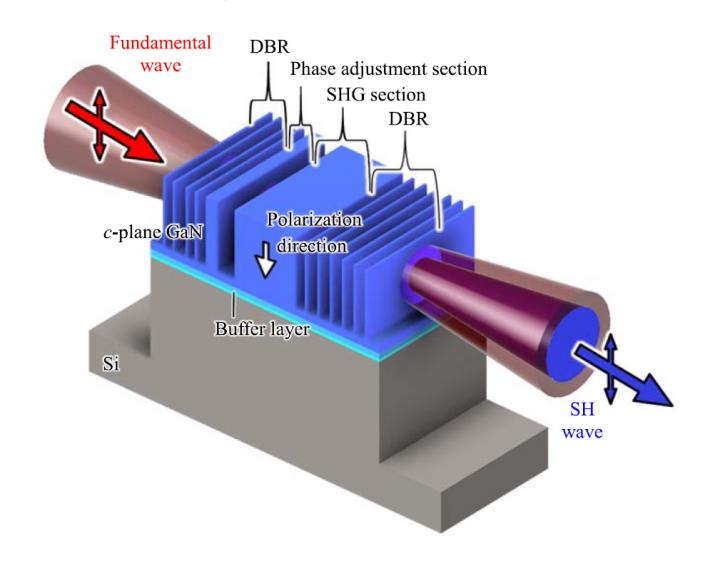Researchers construct a gallium nitride optical microcavity with high reflectivity distributed Bragg reflectors to double the frequency of incoming light, which may be utilized for a safe and practical deep UV light source with bactericidal effects
Osaka, Japan – Researchers from the Graduate School of Engineering and the Center for Quantum Information and Quantum Biology at Osaka University unveiled a new solid state second-harmonic generation (SHG) device that converts infrared radiation into blue light. This work may lead to a practical daily-use deep ultraviolet light source for sterilization and disinfection.
Recently, deep ultraviolet (DUV) light sources have been attracting much attention in sterilization and disinfection. In order to realize a bactericidal effect while ensuring user safety, a wavelength range of 220-230 nm is desirable. But DUV light sources in this wavelength range that are both durable and highly efficient have not yet been developed. Although wavelength conversion devices are promising candidates, conventional ferroelectric wavelength conversion materials cannot be applied to DUV devices due to absorption edge.
Since nitride semiconductors such as gallium nitride and aluminum nitride have relatively high optical nonlinearity, they can be applied to wavelength conversion devices. Due to its transparency to 210 nm, aluminum nitride is particularly suitable for DUV wavelength conversion devices. However, realizing structures with periodically inverted polarity like conventional ferroelectric wavelength conversion devices has proven quite difficult.
“Our device can be adapted to use a broader range of materials. They can be applied to deep ultraviolet light emission or even broadband photon pair generation,” senior author Masahiro Uemukai says. The researchers hope that because this approach does not rely on materials or periodically inverted structures, it will make future nonlinear optical devices easier to construct.
###
The article, “Monolithic microcavity second harmonic generation device using low birefringence paraelectric material without polarity-inverted structure” was published in Applied Physics Express at DOI: https:/
About Osaka University
Osaka University was founded in 1931 as one of the seven imperial universities of Japan and is now one of Japan’s leading comprehensive universities with a broad disciplinary spectrum. This strength is coupled with a singular drive for innovation that extends throughout the scientific process, from fundamental research to the creation of applied technology with positive economic impacts. Its commitment to innovation has been recognized in Japan and around the world, being named Japan’s most innovative university in 2015 (Reuters 2015 Top 100) and one of the most innovative institutions in the world in 2017 (Innovative Universities and the Nature Index Innovation 2017). Now, Osaka University is leveraging its role as a Designated National University Corporation selected by the Ministry of Education, Culture, Sports, Science and Technology to contribute to innovation for human welfare, sustainable development of society, and social transformation.
Website: https:/
Media Contact
Saori Obayashi
[email protected]
Original Source
https:/
Related Journal Article
http://dx.





